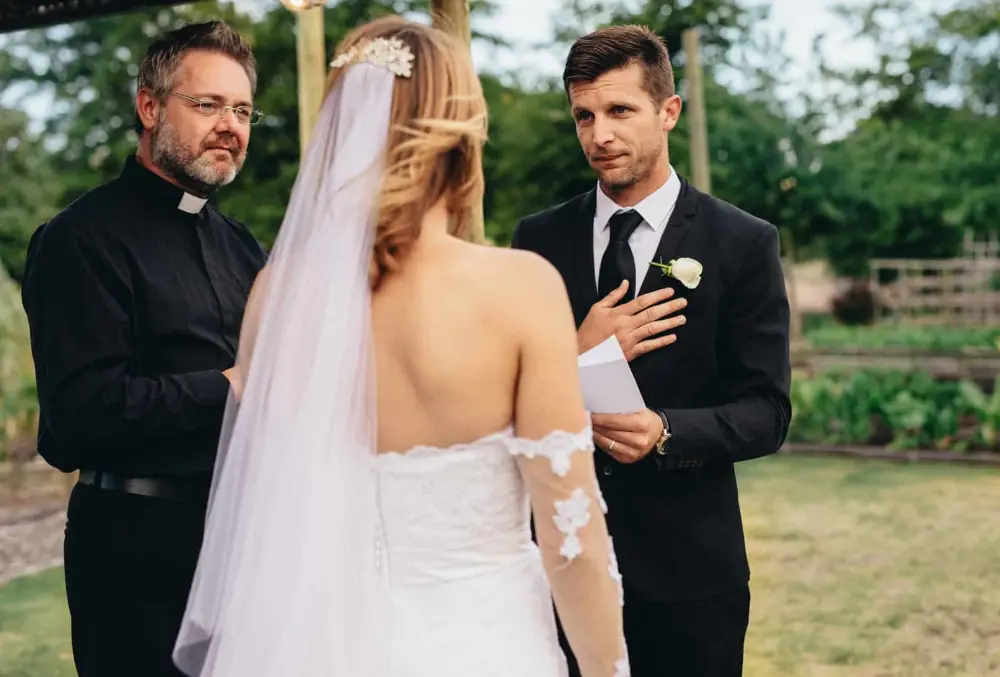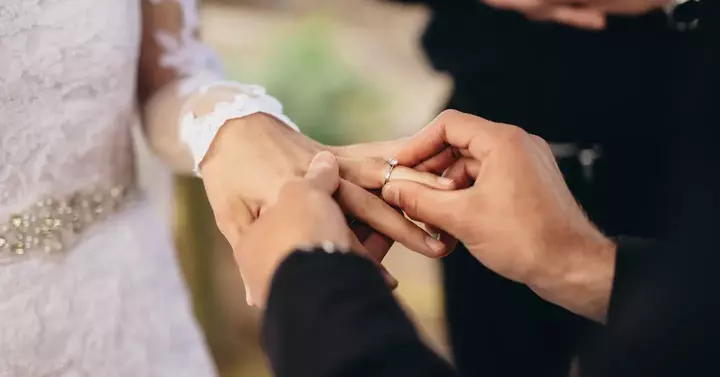Arranging the sequence of a wedding ceremony is essential to guaranteeing a seamless and unforgettable event for both the couple and their guests since it is a joyful and significant occasion. Every component, from the vows and ring exchange to the processional, plays a part in making a lovely and peaceful celebration of love.
This post will walk you through the perfect sequence for the wedding ceremony, breaking down each essential element step-by-step so you can organize and manage the event flawlessly.
What’s a wedding ceremony outline?
In traditional wedding ceremonies, the events occur in the following order: The ceremony begins with the officiant introducing the couple and ends with the vows and ring exchange. However, most wedding ceremonies adhere to the following basic format: “No fuss, no frills, and no extras.”
1. Prelude
The intro is more of a pre-game show or event. Here, your guests will be arriving, mingling, interacting, and getting to know each other. At this stage, you may want to consider a romantic and slow background playlist or a band of musicians.
2. Seating
Perhaps seating is one of the most important things to consider in a wedding ceremony outline. Regarding seating, there are no specific sides, and guests can sit where they like. However, reserving seats at the front for close family members and friends is ideal. Again, this differs depending on location and cultural background.
3. Procession
Now, it’s time for the bridal party to make their entrance. In most wedding ceremonies, the groom and his groomsmen will be in waiting. At times, the groomsmen may escort bridesmaids, and as a rule of thumb, the groomsmen are supposed to assist the groom at all times.
Next, the bridesmaids will slowly walk down the aisle one after each other. If there’s a flower girl or a ring bearer, this is the perfect time for them to enter. A reasonable consideration would be to have separate songs for the bride and the bridal party.
4. Bridal Procession
Now, it’s the perfect time for the star. Now, you must stop all the songs and music and play a new song. The bride should walk down the aisle solo or be accompanied by any other person of her choice (preferably her parent(s)). Who walks the bride down the aisle differs from one cultural background to the next.
5. Wedding Ceremony Introduction (Welcome)
At this point, the music needs to stop. It’s now your officiant’s turn to greet each one of you. The Welcome sets the tone. Whether your day is laid back with a light introduction or more formal with a prayer or opening reading, the Welcome provides a chance to greet and acquaint guests with the ceremony.
6. Offer of Support / Giving of the Bride / Question of Intent
At this point, the officiant will either, in a traditional sense, ask Who gives (their name) to be married or ask parents to offer good support, blessings, and wishes to the marriage. Alternatively, all attendees might be requested depending on what is suitable, or a combination of family members and friends could speak first.
7. Reading / Song / Words / Other Ideas
Now that you have the attention of all the guests, it’s the perfect time for reading a song, poem, or meaningful verse. Be aware that this might be chosen, free-flowing, or several family members or guests sharing their pearls of wisdom, counsel, or well wishes. There are very different ways to include the visitors.
8. Wedding Message
At this point, the officiant will put together a personalized script based on the couple’s information, telling little information regarding their story and noteworthy moments, among other things.
Couples can also share a few things about their qualities, ideas about marriage, and what makes them work as a pair. As the story is told, they can also inject laughter. The couple decides how much personal information is disclosed in this area.
9. Exchanging Vows
Once the wedding message is over, couples can now exchange their vows. Don’t worry if you don’t have your own written vows. Google is your buddy, and your officiant should have prepared some “repeat after me” style vows for you.
10. Ring Exchange
At this point, couples get to exchange rings. To avoid any embarrassment, make sure that you slide the ring on the correct finger. The officiant guides the couples in exchanging the rings at this point.
11. Pronouncement
Now is the perfect time for the groom to kiss the bride after the officiant declares them to be “Husband and Wife” or “Partners in life” to make everything official!
12. Signing
It’s time to sign the marriage license papers officially. Two witnesses should observe the signing, and two songs should be played. (You should give those some thought.)
13. Final words / Toast / Well Wishes / Cake Cutting
We’re heading to the final part of the wedding ceremony. The final part is an opportunity to say a few last things to the newlyweds. A toast or address to the happy couple is a lovely way to cap it all off. A guest or the officiant can express these. At this time, some couples even cut their cake, and there are no strict rules that must be followed here.
14. Recessional
Finally, the recessional. It’s time to celebrate once the officiant introduces the newlyweds! Verify the hierarchy. The bride and groom depart first. Following that, the bridal party may leave.
Remember to have the grandparents and parents be among the first to leave after the bridal party departs. After that, there’s an opportunity to congratulate the bride and groom before the MC introduces himself.
Conclusion
There’s no right or wrong wedding ceremony outline since such differs depending on people and cultural backgrounds. However, most couples today follow what can be termed a modern wedding ceremony outline, such as the one outlined above. Regardless, make sure that your wedding ceremony is truly unique and remarkable.




